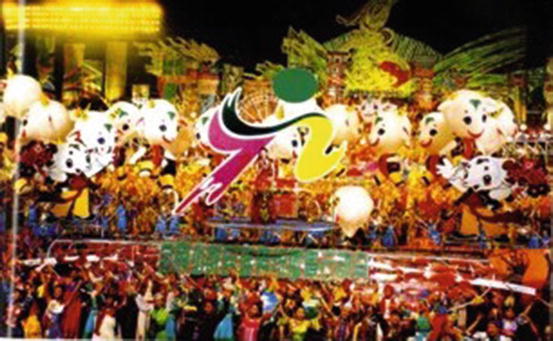Order
Year
Main Host
Members of athletics
Competitive sports
Exhibition sports
1st
1953
Tientsin (天津)
395
5
414
2nd
1982
Hohhot (呼和浩特)
593
2
68
3rd
1986
Ürümchi (烏魯木齊)
777
7
115
4th
1991
Namzning (南寧)
1,500
9
120
5th
1995
Kunming (昆明)
3,300
11
129
6th
1999
Lhasa/Beijing (拉薩/北京)
1,000
14
157
7th
2003
Yinchuan (銀川)
4,900
14
126
8th
2007
Guangzhou (廣州)
6,000
15
150
9th
2011
Guiyang (貴陽)
6,700
16
186
Sport plays a significant role in virtually every country of the world. Traditional ethnic sport is not only a sport, but also serves as a cultural tool of the Chinese universal ideological state apparatus. While several Western scholars have made great contributions to the study of sports and ideology,2 such research still rare in China. In this chapter I describe the development of The Games from 1953 to 2011. I hope to increase an awareness of the nature and importance of these games. The sources utilized in the research for this chapter involved newspapers as well as guidebooks for The Games and miscellaneous reports from 1953 to 2011.
12.2 The History of the Games
12.2.1 The 1st Games in Tientsin (1953)
The first Games were held in Tientsin and took place from November 12th–18th of the year of 1953, in Tientsin (Fig. 12.1). This game was called as ‘The National Ethnic Sports Performance and Athletics Games’, which was the first ethnic sport event in China. The 5-day event has attracted 395 athletes from China’s 133 ethnic minority groups for a total of 483 title events and demonstrations.4
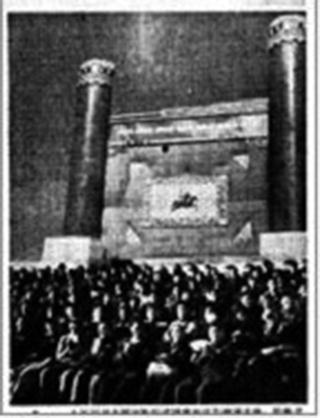

Fig. 12.1
The open ceremony of the first Games (November, 13th, 1953. The people news). Some government officials were present in the open ceremony of the first Games
Nevertheless, from 1966 to 1976, due to the Cultural Revolution, the development of ethnic sports was forbidden from 1966 until 1976. In 1980 the, State Commission of Sports decided that ethnic sports were important, and the Chinese sponsored an ‘ethnic sports investigation conference’.5 This was followed, after a hiatus of 29 years, by the second games which were held in Hohhot, Inner Mongolia, in 1982.
12.2.2 The 2nd Games in Hohhot (1982)
The 2nd games were held from the 10th to the 19th of September, 1982 in Hohhot (Fig. 12.2). This 9-day event attracted 863 athletes from China’s 55 ethnic minority groups and included a total of 4 competitions and 68 demonstrations.
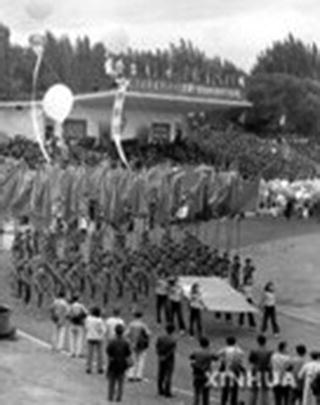

Fig. 12.2
The open ceremony of the 2nd Games (September, 11th, 1982. The people news). Flag being raised during the opening ceremony of the 2nd Games
The purpose of the 2nd Chinese National Ethnic Games was to promote traditional culture, create a national unity, and protect ethnic sports. After the 2nd games, the event was continued and has since been held every 4 years.6
12.2.3 The 3rd Games in Ürümchi (1986)
The 3rd games were held from the 10th–17th of August, 1986 in Ürümchi, the capital of Xinjiang Uygur Autonomous Region (Fig. 12.3). This 9-day event attracted 777 athletes from China’s 55 ethnic minority groups and involved a total of 7 competitions and 115 demonstrations. It was the first time that the event involved the use a badge, a flag and an emblem.
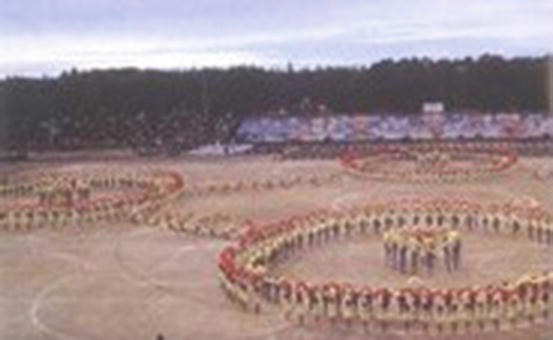

Fig. 12.3
The open ceremony of the 3rd Games. (committee of the 3rd Game (1986). The 3rd Game Guidebook. China, Ürümchi). The gymnastics performance in the open ceremony of the 3rd Games
The purpose of the 3rd Games was to put ethnic policies into practice, to develop and improve the economic situation of ethnic minority groups, and to promote unity and thus aid in the development of China into a superior nation.7
12.2.4 The 4th Games in Namzning
The 4th games were held from the 10th–17th of November, 1991 in Namzning, the capital of Xinjiang Uygur Autonomous Region (Fig. 12.4). The 8-day event attracted 777 athletes from China’s 55 ethnic minority groups and involved a total of 9 competitions and 120 demonstrations.
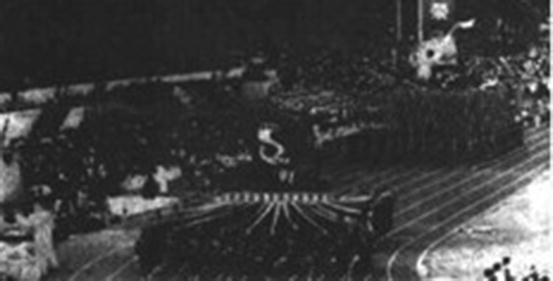

Fig. 12.4
The open ceremony of the 4th Games (August, 5th, 1991. The people news). The emblem had been using from the 4th Games. Athletics are marching into the arena with the big emblem
For these games the purpose was described as augmenting the development of the sports of minority ethnic groups, the creation of equality and unity in ethnic relationships, and the establishment of a prosperous society.8 Beginning with the 4th National Ethnic Games, Taiwan was a participant. The Taiwan delegation was classified as the Gaoshan (高山) group.9
12.2.5 The 5th Games in Kunming
The 5th games took place from the 5th–12th of November, 1995 in Kunming, the capital of Yunnan Province (Fig. 12.5). This 8-day event attracted 2,500 athletes from China’s 55 ethnic minority groups and included a total of 11 competitions and 129 demonstrations. This games’ purpose was described as developing ethnic sport, increasing the ethnic people’s health, strengthening the concept of national unity, inspiring the ethnic spirit, and serving to further the cause of socialism and civilization.10
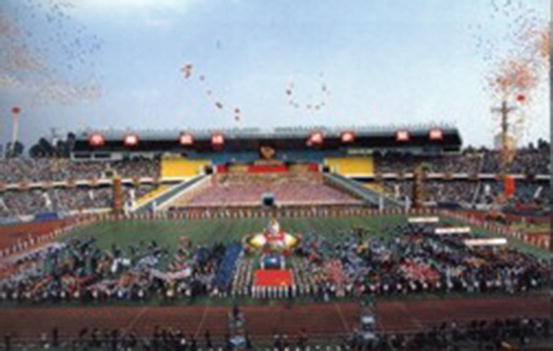

Fig. 12.5
The open ceremony of the 5th Games. The opening performance which was the symbol of peace, prosperity and civilization
12.2.6 The 6th Games in Lhasa and Beijing
The 6th game were held from the 21st–23rd of August, 1999 in Lhasa and from the 24th–30th of September, 1999 in Beijing (Fig. 12.6). The event attracted 6,000 athletes from China’s 55 ethnic minority groups and included a total of 13 competitions and 129 demonstrations. The purpose listed for these games was to disseminate national policy, educate people about the concept of the Chinese union, promote patriotism, and increase the development of civilization.11
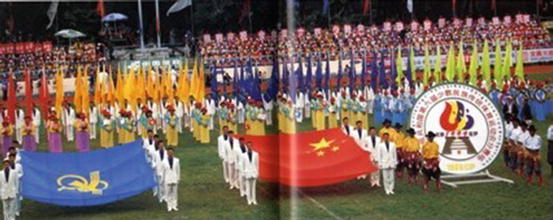

Fig. 12.6
The open ceremony of the 6th Games (Committee of the 6th Game (1999). The 6th Game Report. China, Beijing)
12.2.7 The 7th Games in Yinchuan
The 7th Games were held from the 6th–13th of September, 2003 in Yinchuan (Fig. 12.7). The 7th Games attracted 5,865 athletes from China’s 55 ethnic minority groups and included a total of 14 competitions and 126 demonstrations.

